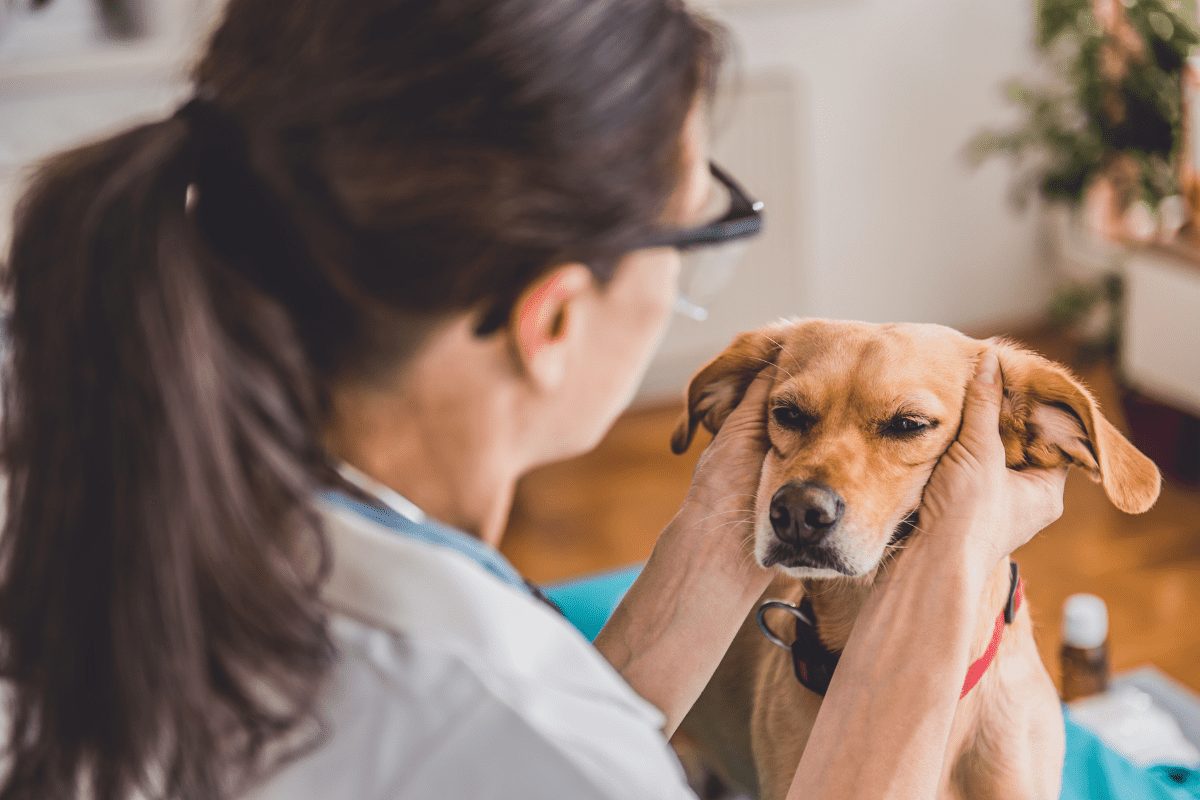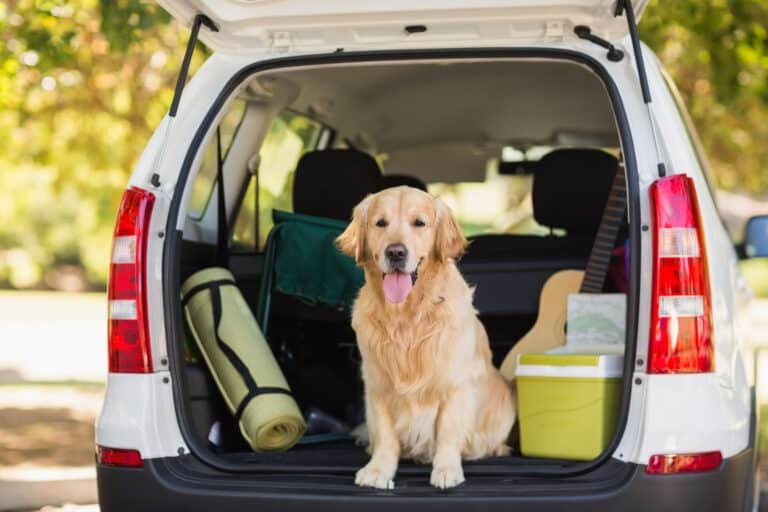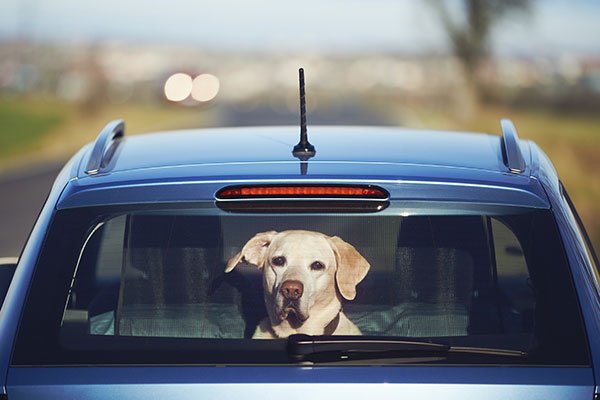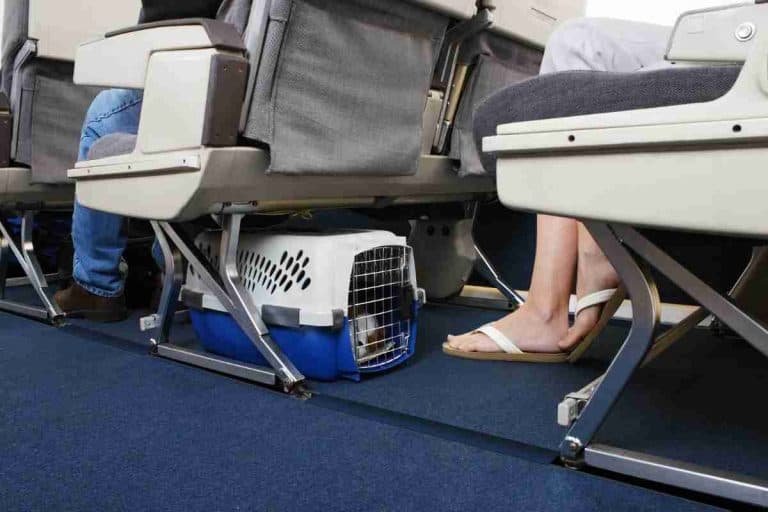Does Flying On A Plane Hurt Your Dog’s Ears? Causes, Signs and How to Help
Last Updated on August 22, 2025
Does flying on a plane hurt your dog’s ears? Sometimes. Rapid cabin pressure changes during takeoff and landing can strain the middle ear. If the Eustachian tube can’t equalize pressure, a dog may feel sharp discomfort or develop barotrauma. Risks rise with ear infections, recent ear procedures, allergies, or brachycephalic anatomy.
Keep reading for causes, clear signs to watch for, and step-by-step ways to help. Get vet-backed prep tips, safe calming tools, and in-flight strategies that encourage swallowing and pressure relief. Learn when ear pain means an emergency and why routine sedation isn’t advised, so air travel stays safer for your dog.
How cabin pressure changes affect a dog’s ears
As an airplane climbs and descends, cabin pressure shifts to match a higher-altitude environment. These changes create pressure differences between the air outside a dog and the air inside the middle ear. When that pressure does not equalize quickly, it strains the eardrum and inner structures, producing discomfort or pain.
Dogs with active ear disease, recent ear surgery, or blocked ear canals carry higher risk. Signs owners can spot include sudden whining, pawing at the head, head tilting, loss of balance, and reluctance to eat. Smaller breeds and puppies may show clearer distress because they cannot verbally signal discomfort.
Practical prevention includes ensuring ears are healthy before travel, scheduling flights when the dog will rest, and avoiding sedatives that blunt protective reflexes. For more on flight-related noise and distress signals, see the coverage on dog whining on plane. If a dog shows significant ear pain or vestibular signs, seek veterinary advice before flying again.
What rapid ascent and descent do to middle-ear pressure
Rapid ascent lowers ambient pressure faster than the middle ear can vent. The trapped air in the middle ear expands and pushes outward against the eardrum. Rapid descent raises ambient pressure, creating negative pressure in the middle ear that pulls the eardrum inward. That inward pull often causes the sharpest pain.
When pressure equalization fails, the dog may develop barotrauma. Barotrauma can inflame the middle ear, cause bleeding, or, in severe cases, rupture the eardrum. Watch for sudden yelps, ongoing shaking, persistent head tilt, or disorientation after a flight. These signs warrant immediate veterinary examination.
Simple measures reduce risk: fly when the dog is calm, encourage swallowing by offering water or short treats during descent, and choose flights with gradual climbs and descents when possible. For behavior and noise-related issues that can indicate ear discomfort during a flight, owners can review resources such as what happens if my dog barks on a plane.
Canine Eustachian tube and differences from humans
The Eustachian tube connects the middle ear to the back of the throat and helps equalize pressure. Dogs use similar swallowing and yawning mechanisms to open that tube. However, canine anatomy and ear-canal structure differ from humans, and these differences influence how well pressure equalizes.
Dogs commonly develop external or middle ear infections because of ear-canal shape and hair growth. Existing infections or inflammation can block the Eustachian tube and prevent normal equalization during flight. Brachycephalic breeds also often have airway and sinus differences that complicate pressure regulation.
Before travel, a veterinarian should clear active ear disease. Owners should avoid inserting objects into the ear and should not rely on over-the-counter human remedies. For protection of the outer ear during water exposure or travel, some owners review solutions like dog ear plugs for swimming, but note that plugs affect only the external canal and do not equalize middle-ear pressure. When in doubt, ask a vet for breed-specific recommendations and safe preflight treatments.
Why some dogs are more likely to have trouble
Air travel changes cabin pressure and forces a dog’s middle ear to equalize rapidly. Dogs with certain anatomy or health problems cannot equalize pressure as efficiently. That inability increases the risk of ear pain, barotrauma, or a flare of existing ear disease. Owners should identify which dogs face higher risk before booking a flight.
Risk factors by breed and skull shape (brachycephalic vs. others)
Brachycephalic breeds—such as bulldogs, pugs, and other snub-nosed dogs—face greater risk. Short skulls compress nasal passages, narrow airways, and alter Eustachian tube function. Those changes reduce pressure equalization and raise chances of painful ears and breathing difficulty during ascent or descent. Longer-muzzled breeds usually equalize pressure more easily but can still suffer if they have ear disease. Owners of snub-nosed dogs should check airline rules and risks; see policies for airlines that allow snub-nosed dogs before travel planning.
Existing ear or respiratory conditions that increase risk
Chronic otitis externa or media, Eustachian tube dysfunction, severe allergies, and upper respiratory disease raise the chance of in-flight ear pain. Respiratory conditions such as brachycephalic obstructive airway syndrome (BOAS) or collapsed trachea compound the problem by limiting airflow. Dogs with recent ear infections often retain fluid or inflammation that blocks pressure equalization. A veterinary exam within 72 hours of travel can reveal treatable conditions and reduce risk.
Action step: Obtain pre-flight clearance and a written management plan from the veterinarian. That plan may include treatment, a recommendation to avoid flying, or specific monitoring steps for the flight.
How to recognize ear pain or pressure during travel
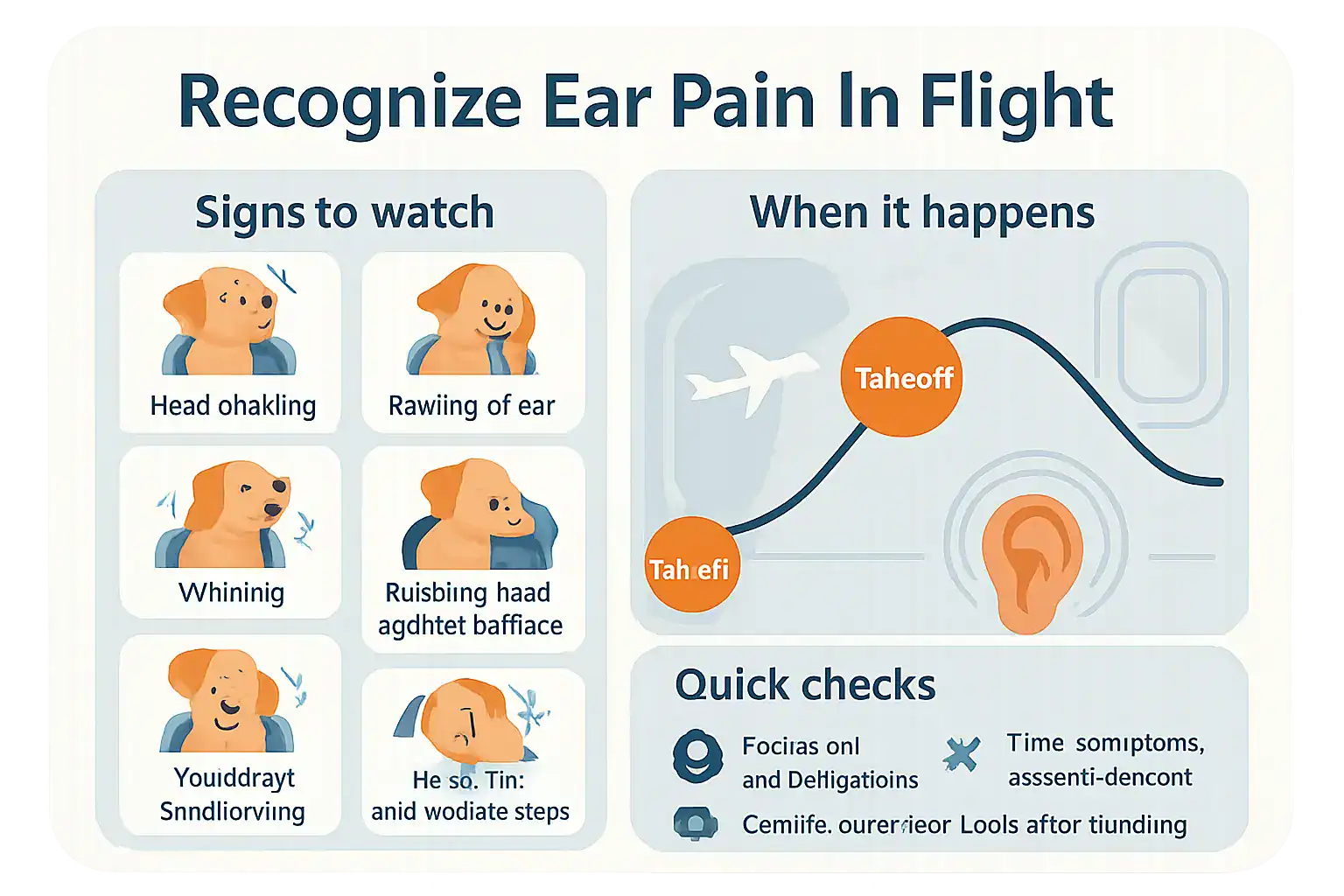
Dogs experience ear pressure changes during flight much like humans. Rapid altitude shifts can stretch the eardrum and irritate the middle ear. Watch for subtle shifts in behavior around takeoff and landing because those are the moments pressure changes most.
Common signs include repeated head shaking, persistent pawing at one or both ears, increased whining or vocalizing, and rubbing the head against surfaces. Appetite changes, reluctance to move, and reduced interest in treats also appear when ears bother a dog. Less common but important signs include a sudden head tilt, loss of balance, or disorientation.
Quick checks owners can do:
- Observe ear-focused behaviors rather than general anxiety.
- Note timing—if symptoms peak during climb or descent, pressure likely causes them.
- After landing, inspect the outer ear for redness, discharge, or blood only if the dog allows gentle handling.
Persistent whining often overlaps with travel anxiety, but the two differ. For guidance on vocal travel behaviors and calming strategies, see dog whining on plane.
Typical behaviors to watch for on takeoff and landing
Takeoff and landing trigger the fastest pressure changes. Expect behaviors that indicate immediate discomfort. Whining, sudden barking, repeated head shakes, and pawing at ears appear quickly. A dog might press its head to the carrier or floor, try to climb onto a lap, or refuse treats.
Also watch for yawning, frequent swallowing, and lip licking. These signs show the dog is trying to equalize ear pressure. Distinguish them from motion sickness signs such as continuous drooling, nausea, or retching. Motion sickness tends to persist rather than spike only during ascent or descent.
Small, practical interventions can help: offer a chew or a soft toy during descent to encourage swallowing, gently massage the base of the ear if the dog tolerates it, and speak calmly to reduce panic. Owners should avoid ear drops or probing the ear canal during flight. For guidance on in-flight noise and behavior consequences, consult what happens if my dog barks on a plane. If symptoms continue after landing, contact a veterinarian promptly.
Serious signs that suggest immediate veterinary care
Certain signs demand urgent attention. Seek emergency care if the dog shows continuous vomiting, seizures, collapse, severe head tilt, or sudden deafness. Visible bleeding from the ear, bloody discharge, or a bulging eardrum also indicates possible barotrauma or tympanic membrane rupture.
Vestibular signs—extreme loss of balance, uncontrolled eye movements (nystagmus), or inability to stand—suggest middle ear or inner ear involvement. Respiratory distress or pale gums point to systemic problems and require immediate intervention. Do not administer human medications or attempt deep ear cleaning.
What to do immediately:
- Notify cabin crew or cargo handlers and request medical assistance upon landing.
- Keep the dog calm, warm, and restrained to prevent further injury.
- Seek an emergency veterinary clinic on arrival and describe the timing and progression of symptoms.
Brachycephalic breeds face higher risks during air travel; owners should review airline policies for these dogs and plan extra precautions. See airlines that allow snub-nosed dogs for breed-specific considerations. If signs are severe, act immediately—delaying care can worsen ear damage or lead to permanent hearing loss.
What to cover with your veterinarian before flying
Before any flight, owners should book a focused pre-flight visit to evaluate ear health and overall fitness to travel. The veterinarian will balance ear-specific concerns with general travel safety. Topics to address include recent ear infections, history of ruptured eardrums, neurologic signs, persistent head shaking, and any vestibular episodes. Owners should bring medical records, a list of current medications, and notes on past travel reactions.
Request a discussion about travel mode and crate requirements. Different carriers and routes create varying pressure, noise, and temperature exposures. The vet can suggest practical gear and handling tips for the chosen travel method. For broader travel preparation and crate advice, consult essential dog travel tips and gear.
Ask the clinic to document any exam findings and to provide a dated health certificate if required by the airline. This visit also serves as the moment to schedule follow-up care after travel if needed. Owners should leave the appointment with a clear plan and next steps, including whether to delay travel for ear treatment. Consider asking the clinic to reserve a phone check-in on the day of travel.
Pre-flight ear exam, tests and history to discuss
The veterinarian will perform a targeted otoscopic exam and assess the ear canal and tympanic membrane. Detecting redness, discharge, swelling, or a ruptured eardrum changes treatment and travel advice. If the vet suspects middle-ear disease or a deep infection, they may recommend cytology, bacterial culture, or imaging to clarify the diagnosis.
Owners should report symptoms such as head tilt, sudden hearing loss, balance problems, or repeated ear cleaning. These signs suggest inner-ear involvement and may make flying unsafe. The clinic will also check cranial nerve function and reflexes to rule out neurologic causes of ear pain.
Bring records of past topical ear medications and outcomes. Prior responses to ear drops, allergy treatments, or oral antibiotics guide next steps. If ear plugs or ear care products are part of the plan, discuss safe use before flight. See product and protection options at dog ear plugs for swimming.
Guidance on ear drops, antibiotics or anti-anxiety meds
Treatment decisions depend on exam findings and test results. For superficial otitis, a topical antimicrobial or antifungal may suffice. The vet will confirm the tympanic membrane is intact before prescribing ear drops. If the eardrum is ruptured, topical drops may harm the middle ear; systemic antibiotics then become the safer option.
Discuss the appropriate duration and follow-up for any antibiotic. Incomplete courses risk recurrence and resistance. If inflammation causes pain, a short steroid course may reduce swelling and pressure symptoms. The veterinarian will weigh benefits against contraindications.
For anxious dogs, vets recommend evidence-based options. Behavioral strategies and non-prescription measures can help. For owners exploring alternatives to pharmaceuticals, review natural approaches and calming protocols at 9 natural ways to remedy your dog’s travel anxiety. Medications such as gabapentin or trazodone may be appropriate, but the clinician must tailor dosing to the dog’s health and travel conditions.
Advice on sedation and safety considerations for flights
Many airlines and veterinarians caution against routine sedation for air travel. Sedatives can depress respiration and alter the dog’s ability to balance pressure changes. These effects carry added risk in cargo holds or on long flights. Before prescribing sedatives, vets will consider the dog’s breed, age, cardiac and respiratory status, and whether the dog will fly in cabin or cargo.
Airlines often forbid sedated pets or require special documentation. Owners should confirm carrier policies and flight class early. If sedation is considered the only option, the veterinarian will review risks, choose an appropriate drug, and advise monitoring plans. Alternatives include acclimation training, crate conditioning, and short-acting anxiolytics used under veterinary guidance.
For details on cabin options and airline rules, review regulations at airlines that allow dogs in cabin. Always obtain a signed health certificate when required. CTA: schedule the pre-flight exam early to allow treatment and recheck visits before travel.
Pre-flight preparations to reduce ear discomfort

Dogs can feel pressure changes during ascent and descent much like humans. Rapid pressure shifts strain the middle ear and Eustachian tube. That strain becomes painful when a dog cannot equalize pressure because of congestion, ear infection, or blocked ear canals. A pre-flight vet check helps identify ear infections, ruptured eardrums or excess wax that increase risk. Vaccinations and health certificates also matter for airline travel.
Owners should plan several days of preparation rather than a single check before travel. Clean visible debris from the outer ear only if a veterinarian approves. Avoid over-the-counter decongestants without veterinary guidance—some are unsafe for dogs. If the vet prescribes medication to reduce congestion or inflammation, follow dosing and timing exactly so the drug is effective during the flight.
Gather travel gear early: a well-ventilated carrier that fits airline rules, absorbent pads, and a familiar blanket. For broader gear and travel planning advice, see essential dog travel tips and gear for road trips. Preparing equipment and the dog well ahead reduces stress and lowers the chance of ear discomfort on travel day.
Conditioning to the carrier and practice short trips
Carrier conditioning helps a dog remain calm, which aids normal ear function during pressure changes. Start by placing the carrier in a common area with the door open. Put treats, toys, and bedding inside so the carrier becomes a positive space. Gradually build up the dog’s time inside the carrier from minutes to an hour.
Next, introduce short car trips. Drive for five to 10 minutes at first, then slowly increase trip length over several sessions. These drives teach the dog to tolerate motion, confinement and the sounds of travel. Include one session that ends at a quiet outdoor spot for a potty break and praise, reinforcing calm behavior when exiting the carrier.
When the dog tolerates car rides and the carrier at home, move to trips that mimic airport handling. Practice carrying the closed crate short distances and using an elevator or stairs to approximate altitude-related pressure experiences. For practical crate options and securing tips, consult the best dog crates for car travel. Conditioning reduces anxiety and helps the dog swallow and yawn normally during a flight.
Timing food, water and exercise before travel
Proper timing of feeding, hydration and exercise lowers the chance of vomiting and helps a dog equalize ear pressure. Offer a light meal about three to four hours before departure. Avoid large meals within two hours of travel to reduce nausea. Allow drinking up until one to two hours before leaving, then limit excess water near boarding.
Give the dog a moderate exercise session roughly one to two hours before going to the airport. A brisk walk or play session helps empty the bladder and bowel and reduces nervous energy. After exercise, let the dog rest and settle so it enters the carrier calm and able to swallow normally during ascent and descent.
If a dog tends to drool or vomit, discuss anti-nausea medication or alternative strategies with a veterinarian. Also confirm any timing for prescribed allergy or congestion meds so they peak during flight. For guidance about bathroom logistics while flying, read how dogs handle bathroom needs on a plane at how dogs handle bathroom needs on a plane.
Choosing flights and carriers to minimize pressure events
Flight selection affects ear pressure exposure. Choose direct flights to avoid multiple climbs and descents. Book flights at times with historically smoother operations—midday flights often have more stable conditions than early morning or late-night connections.
Whenever possible, keep the dog in the cabin rather than in checked cargo. Cabin travel allows the owner to soothe the dog, encourage swallowing, and notice signs of ear pain. Cargo holds often experience greater temperature and pressure variability and raise risk for ear- or respiratory-related complications.
Match the carrier to airline size rules and the dog’s ability to move, stand, and turn. A carrier that restricts posture prevents natural swallowing or yawning during descent. Check airline policy before booking; many publish allowed dimensions and breed restrictions. For a list of airlines that permit dogs in the cabin and policy details, see airlines that allow dogs in cabin. Always confirm requirements and reserve a cabin spot early to minimize last-minute changes.
In-flight strategies to help equalize pressure and calm your dog
Pressure changes during ascent and descent can cause ear discomfort in dogs. Flight plans that focus on active equalization and stress reduction lower that risk. Start by scheduling a vet check and confirming the dog is fit to fly. During boarding and climb, aim for behaviors that promote swallowing and yawning, which open the Eustachian tubes. Offer controlled opportunities to swallow, and pair those with calm handling and predictable cues.
Managing anxiety prevents exaggerated vocalizing and restlessness, which aggravate ear pain. Short, familiar routines—quiet petting, a favored chew offered at key moments, or a practiced command—help the dog associate the flight with safety. Monitor respiration and body language closely for signs of discomfort. When a dog becomes highly agitated, crews may ask to move or adjust positioning; plan for that possibility before travel.
For practical tips on handling vocal stress and discomfort in flight, consult resources about dogs who cry or whine on planes, such as how to deal with dog whining on a plane. These recommendations complement the swallowing and calming strategies below.
Chews, treats and swallowing cues that encourage equalization
Chews and treats work because they trigger swallowing, which equalizes middle-ear pressure. Choose small, soft chews that dissolve or require gentle gnawing. Hard or brittle chews can pose a choking risk when the dog panics. Time treats for the most rapid pressure shifts: give one just before takeoff and a few during descent.
Training simple swallowing cues ahead of travel helps. Teach a short cue—like “swallow” or “chew”—paired with a treat during low-stress practice sessions. Use the same cue in-flight so the dog understands the action reduces ear discomfort. For puppies or seniors, break treats into smaller portions and supervise closely.
Avoid feeding large meals within two hours of the flight. Full stomachs increase motion-sickness risk and reduce the chance the dog will accept chews. If motion sickness is a concern, consult a vet for preflight guidance rather than experimenting midair.
Calming tools: pheromones, wraps, music and vet-approved supplements
Calming measures reduce anxiety-driven behaviors that worsen ear pain. Dog-appeasing pheromone sprays and wipes can create a reassuring scent in carriers. Anxiety wraps or snug jackets provide proprioceptive feedback; many dogs respond with reduced restlessness. Soft, familiar bedding and an unwashed item of the owner’s clothing also helps.
Low-volume, species-specific calming music soothes many dogs during travel. Use playlists designed for canine relaxation and test them on short trips first. For dogs with moderate to severe anxiety, discuss vet-approved supplements or medications before travel. A veterinarian can recommend products that won’t affect swallowing reflexes or respiratory function.
For additional natural strategies to relieve travel anxiety and keep a dog calm in motion, see 9 natural ways to remedy a dog’s travel anxiety. Always test tools on the ground before using them in flight.
Placement, positioning and monitoring while in the cabin or cargo
Where a dog rides affects monitoring and the ability to intervene. Cabin placement under the seat allows direct visual and tactile contact, enabling the owner to encourage swallowing and comfort. Use a soft-sided carrier that fits airline rules and allows the dog to change head position. When permitted, position the carrier so the dog faces the owner; that orientation eases stress.
Cargo travel raises different concerns. Dogs in cargo cannot benefit from in-cabin swallowing cues or immediate owner comfort. If cargo is the only option, choose nonstop flights, mid-size crates with secure ventilation, and label the crate clearly. Check airline policies and consider airlines experienced with pet cargo transport.
Know airline rules and crate recommendations before booking. For details on carriers and cargo policies, review airline-specific guidance such as airlines that allow dogs in the cargo. Monitor the dog closely before boarding for signs of ear pain, and delay travel if the dog shows middle-ear infection symptoms.
After the flight — monitoring, first-aid and follow-up care

A focused post-flight check helps catch ear pain, infection or vestibular problems early. Owners should observe behavior, appetite and mobility for several hours after landing. Note any head tilt, circling, rapid eye movements, disorientation, repeated head shaking, ear scratching or vocalizing. Visible redness, foul-smelling discharge, swelling or bleeding indicate a likely ear problem. Keep a record of onset time and any signs; photos or short videos help the veterinarian assess severity.
Post-flight checks for infection, pain or vestibular signs
Begin with a calm, well-lit visual exam. Look at outer ear for swelling, discharge or foreign material. Gently lift the ear flap; do not insert cotton swabs into the canal. Palpate the base of the ear for heat or pain reactions. Watch the dog walk in a straight line and stand on all limbs. Vestibular signs include head tilt, stumbling and rhythmic eye movements (nystagmus). Persistent whining or distress on or after the flight may signal pain or anxiety—see guidance on calming a noisy pup: dog whining on plane.
Immediate at-home steps and when to see a vet
Keep the dog quiet and supported. Offer water and a soft place to rest. Apply a warm compress externally for 5–10 minutes to help comfort a painful ear. Do not give human painkillers; many are toxic to dogs. Call the veterinarian if signs include worsening balance loss, vomiting, collapse, continuous head tilt, blood or pus from the ear, fever, or severe pain. The vet may prescribe analgesics, topical or systemic antibiotics, or recommend ear flushing and imaging if needed. Prepare flight details, timing of signs, and any photos before the visit. If signs are acute or severe, seek emergency care immediately.
Quick answers to common concerns
Short, direct answers help pet owners decide what to do during air travel. Pressure changes can affect dogs, but species differences, stress and other factors change each case. Below are concise responses to the most common questions owners ask before a flight.
Do dogs’ ears “pop” the same way humans’ do?
Dogs have Eustachian tubes and can experience middle-ear pressure shifts. They usually do not report the same conscious “pop” sensation humans describe. Instead, pressure discomfort shows as restless behavior, head shaking, ear scratching, whining, or loss of appetite. Very rarely, severe pressure changes can cause ear pain or a balance issue. Owners should watch behavior during climb and descent for sudden changes and contact a vet if symptoms persist after landing.
Are ear muffs or dog ear plugs useful and safe?
Ear muffs reduce noise but do not equalize pressure. Ear plugs designed for dogs—mainly for swimming—block sound and water, not cabin-pressure changes. Using plugs can trap moisture and raise infection risk if not cleaned properly. If an owner considers ear protection, choose well-fitting muffs for anxiety and consult a veterinarian about ear health first. More on product options appears in this guide to dog ear plugs for swimming.
Is sedation recommended for preventing ear pain?
Sedation is not a routine recommendation to prevent ear pain. Sedatives can blunt protective reflexes and increase travel risk. Vets may prescribe mild anxiolytics or anti-nausea medicine for anxious dogs, but only after an exam. Safer strategies include training for carrier comfort, feeding or chewing during ascent and descent to encourage swallowing, and scheduling a preflight veterinary check. Owners should consult their veterinarian before using medication or devices.
Summary
Air travel can hurt a dog’s ears when cabin pressure changes faster than the middle ear can equalize, especially during descent. The post explains how this pressure mismatch can lead to discomfort or barotrauma, which shows up as whining, pawing at the ears, head tilt, or balance problems. Dogs with active ear disease, recent ear procedures, or brachycephalic anatomy face higher risk.
Owners can lower that risk with a vet check before flying, choosing direct in-cabin flights, conditioning to the carrier, timing food and water, and encouraging swallowing with soft chews during ascent and descent. The guide outlines clear in-flight strategies, what to avoid (like routine sedation or human medications), and post-flight checks, plus when to seek urgent veterinary care.
Key Takeaways
- Pressure changes during takeoff and especially descent can strain the eardrum; failed equalization may cause barotrauma with pain, inflammation, or eardrum rupture.
- High-risk dogs include brachycephalic breeds and those with ear infections, allergies, or respiratory disease; schedule a targeted pre-flight exam (ideally within 72 hours) and follow the vet’s plan.
- Prep smart: condition the dog to the carrier, clean only the outer ear if a vet approves, time meals and hydration, and avoid over-the-counter human remedies without veterinary guidance.
- Flight choices matter: pick direct routes, keep the dog in-cabin when possible, and use a carrier that allows head movement to support natural swallowing and yawning.
- In-flight help: offer small, soft chews or sips of water during ascent and descent, use calming tools (pheromones, wraps, music), and avoid routine sedation unless a vet prescribes it.
- After landing: check for head tilt, nystagmus, bleeding, foul discharge, or severe pain; seek immediate veterinary care for serious or persistent signs.
FAQ
- What causes a dog’s ears to hurt on planes? Cabin pressure shifts create a difference between outside air and the middle ear. If the Eustachian tube doesn’t equalize quickly—most often during descent—pain or barotrauma can occur.
- How can owners help equalize their dog’s ear pressure in flight? Time soft chews or small sips of water for takeoff and descent, keep the dog calm with familiar routines, and position the carrier to allow comfortable head movement.
- Why are brachycephalic breeds and dogs with ear disease at higher risk? Short skulls and airway changes can hinder Eustachian tube function, while inflammation or infection blocks normal equalization, raising the chance of pain and complications.
- What signs suggest barotrauma after a flight? Persistent head tilt, disorientation, nystagmus, ear bleeding or discharge, marked pain, or sudden hearing loss warrant immediate veterinary evaluation.
- How should medications and sedation be handled for flights? Avoid routine sedation; it can depress breathing and blunt protective reflexes. Use only veterinarian-prescribed treatments (e.g., anti-nausea or anxiolytics) tailored to the dog and flight plan—never give human medications.

